Palairet Surname Ancestry ResultsOur indexes 1000-1999 include entries for the spelling 'palairet'. In the period you have requested, we have the following 36 records (displaying 21 to 30): Single Surname Subscription | | | Buying all 36 results of this search individually would cost £168.00. But you can have free access to all 36 records for a year, to view, to save and print, for £100. Save £68.00. More... |
These sample scans are from the original record. You will get scans of the full pages or articles where the surname you searched for has been found. Your web browser may prevent the sample windows from opening; in this case please change your browser settings to allow pop-up windows from this site. Boys entering Harrow School
(1890)
This Second Volume of the Second Series of the Harrow School Register was edited by J. H. Stogdon and published in 1925. The boys are listed by term of entrance, and then alphabetically by surname and christian names (in bold). Next, in brackets and in italics, is the school house to which he belonged - or, H. B. indicating a day boy whose family lived in Harrow. Stogdon then gives the father's surname and initials, and address. In cases where the boy was prominent in sports at school, or won academic prizes, scholarships &c., that is given; then the year of leaving the school; a synopsis of his career; and, where known, his address as of 1925, in italics. PALAIRET. Cost: £4.00.  | Sample scan, click to enlarge
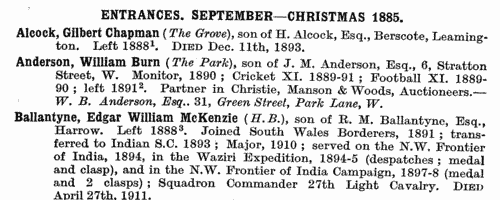
| Eton College boys and masters
(1900)
Printed lists of boys attending Eton College were issued each School-Time or term. This is the list for Midsummer School-Time, 1900. The governors and masters of the schools are given first: then the names of a scholar elected for King's in December 1899, and the names and ages of 16 scholars elected for Eton in July 1899, 15 of whom had been admitted. Winners of the Newcastle Scholarship, two each year, back to 1829, and of the various college scholarships and prizes for 1899 and 1900, precede the Distinctions in Trials (examinations) for March 1900. The First Hundred and Certificate examination list for Election 1899 list the boys in order of merit and with the marks awarded in Classics, Mathematics, Scripture Knowledge and History. The Certificate list is divided into First, Second and Third Classes, Passed, and Failed. The names of examiners and absentees are also given. Then follow the main lists of all the pupils, arranged by class. For every boy his position in class, surname, house tutor's name and classical tutor's name, are given; and evey boy's entry is annotated with details of his prizes during his whole period at the school. In the fifth forms the list for each class is divided into four parts, divided by a dotted line, then a wavy line, and then a full line. The top fourth had all obtained distinction in the last trials; those above the wavy line had been classed in the last trials; next were the unclassed; and below the full line were those boys who had failed in the trials.
PALAIRET. Cost: £6.00.  | Sample scan, click to enlarge
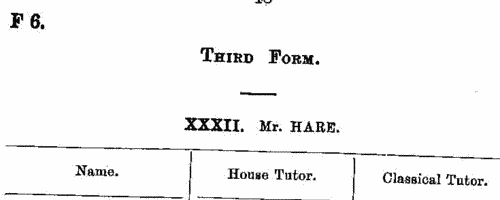
| Eton College boys and masters
(1900)
Printed lists of boys attending Eton College were issued each School-Time or term. This is the list for Michaelmas School-Time, 1900. The governors and masters of the schools are given first: then the names of a scholar elected for King's in December 1899, and the names and ages of 20 scholars elected for Eton in July 1900, 12 of whom had been admitted. Winners of the Newcastle Scholarship, two each year, back to 1829, and of the various college scholarships and prizes for 1899, precede the Distinctions in Trials (examinations) for July 1900. The First Hundred and Certificate examination list for Election 1900 list the boys in order of merit and with the marks awarded in Classics, Mathematics, Scripture Knowledge and History. The Certificate list is divided into First, Second and Third Classes, Passed, and Failed. The names of examiners and absentees are also given. Then follow the main lists of all the pupils, arranged by class. For every boy his position in class, surname, house tutor's name and classical tutor's name, are given; and evey boy's entry is annotated with details of his prizes during his whole period at the school. In the fifth forms the list for each class is divided into four parts, divided by a dotted line, then a wavy line, and then a full line. The top fourth had all obtained distinction in the last trials; those above the wavy line had been classed in the last trials; next were the unclassed; and below the full line were those boys who had failed in the trials.
PALAIRET. Cost: £6.00.  | Sample scan, click to enlarge
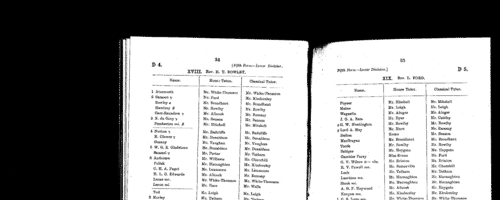
| Eton College boys and masters
(1900)
Printed lists of boys attending Eton College were issued each School-Time or term. This is the list for Lent School-Time, 1900. The governors and masters of the schools are given first: then the names of a scholar elected for King's in December 1899, and the names and ages of 16 scholars elected for Eton in July 1899, 12 of whom had been admitted. Winners of the Newcastle Scholarship, two each year, back to 1829 (here indexed from 1859 onwards), and of the various college scholarships and prizes for 1899, precede the Distinctions in Trials (examinations) for December 1899. The First Hundred and Certificate examination list for Election 1899 list the boys in order of merit and with the marks awarded in Classics, Mathematics, Scripture Knowledge and History. The Certificate list is divided into First, Second and Third Classes, Passed, and Failed. The names of examiners and absentees are also given. Then follow the main lists of all the pupils, arranged by class. For every boy his position in class, surname, house tutor's name and classical tutor's name, are given; and evey boy's entry is annotated with details of his prizes during his whole period at the school. In the fifth forms the list for each class is divided into four parts, divided by a dotted line, then a wavy line, and then a full line. The top fourth had all obtained distinction in the last trials; those above the wavy line had been classed in the last trials; next were the unclassed; and below the full line were those boys who had failed in the trials.
PALAIRET. Cost: £6.00.  | Sample scan, click to enlarge
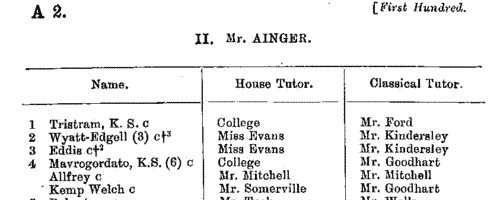
| Boys entering Sherborne School
(1914)
The grammar school at Sherborne in Dorset, which doubtless existed from the creation of the diocese of Sherborne in 705, was refounded by king Edward VI in 1550. At the quatercentenary in 1950, a fourth edition of the Sherborne Register was published, listing boys entering the school during those four centuries. In truth, the materials for this register survive but fitfully before 1823; for some years, no names are known; sometimes all that is known is a surname. But from 1823 onwards the lists and the details get steadily more comprehensive. By the 20th century the boys are listed alphabetically by surname under term of entrance. Surname is given in bold, then christian names, name of father (surname and initials) and address; year of birth; house (a, School House; b, Abbey House; c, The Green; d, Harper House (formerly The Retreat); f, Abbeylands; g, Lyon House; h, Westcott House); whether represented the school at cricket (xi), football (xv), shooting (viii), &c.; year of leaving; summary of degrees, career &c.; and (in italics), address as of 1950. Names in the early lists marked with an asterisk are found inscribed on the oak panelling or on the stone walls of the former schoolroom. (F) in the lists indicates a foundationer, receiving free education: after 1827, when this privilege was restricted to boys from Sherborne and neighbourhood, nearly all foundationers were day-boys.PALAIRET. Cost: £4.00.  | Sample scan, click to enlarge
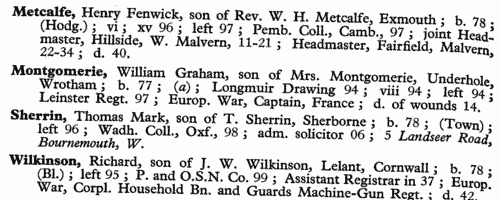
| War Services of British Army Officers
(1915)
Hart's Annual Army List, Special Reserve List and Territorial Force List for 1915 includes this section entitled 'War Services of the Officers of the Active List', covering not only serving officers of the regular army, but also officers of the militia (marked (m)), special reserve (r), territorials (t), volunteers (v) and yeomanry (y). The detailed descriptions of the officers' war services relate not to the Great War, but to previous campaigns, particularly those in South Africa, Egypt, India and China. The regiment &c. in which the officer was currently serving is shown in brackets after his name. PALAIRET. Cost: £6.00.  | Sample scan, click to enlarge
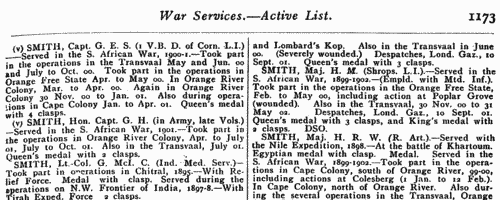
| Naval Officers
(1920)
The alphabetical list of officers on the Active List of the Royal Navy and Royal Marines (RM) and of the Retired and Emergency Officers serving gives: number of ship or where otherwise serving; name (surname, first christian name and initials); rank; and the dates of their seniority. This is the list from the March 1920 edition of the Navy List, corrected to 18 February 1920.
PALAIRET. Cost: £4.00.  | Sample scan, click to enlarge
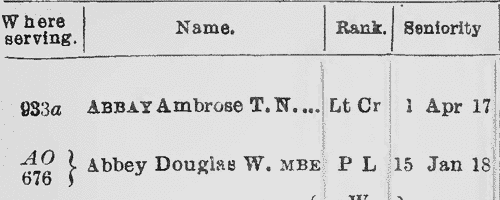
| Boys entering Sherborne School
(1928)
The grammar school at Sherborne in Dorset, which doubtless existed from the creation of the diocese of Sherborne in 705, was refounded by king Edward VI in 1550. At the quatercentenary in 1950, a fourth edition of the Sherborne Register was published, listing boys entering the school during those four centuries. In truth, the materials for this register survive but fitfully before 1823; for some years, no names are known; sometimes all that is known is a surname. But from 1823 onwards the lists and the details get steadily more comprehensive. By the 20th century the boys are listed alphabetically by surname under term of entrance. Surname is given in bold, then christian names, name of father (surname and initials) and address; year of birth; house (a, School House; b, Abbey House; c, The Green; d, Harper House (formerly The Retreat); f, Abbeylands; g, Lyon House; h, Westcott House); whether represented the school at cricket (xi), football (xv), shooting (viii), &c.; year of leaving; summary of degrees, career &c.; and (in italics), address as of 1950. Names in the early lists marked with an asterisk are found inscribed on the oak panelling or on the stone walls of the former schoolroom. (F) in the lists indicates a foundationer, receiving free education: after 1827, when this privilege was restricted to boys from Sherborne and neighbourhood, nearly all foundationers were day-boys.PALAIRET. Cost: £4.00.  | Sample scan, click to enlarge
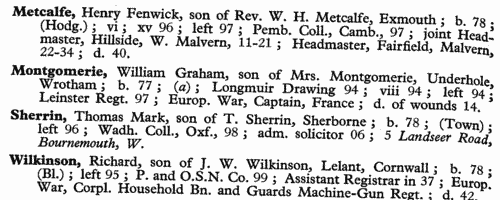
| Officers of the British Army and of the Indian Army
(1934)
The Half-Yearly Army List, issued By Authority, 30 June 1934, lists all officers in active service at that date, and this list was evidence of the status and rank of the officers contained in it. The entries are set out as a gradation list, by rank, from field-marshals to lieutenants, and within each rank in order of seniority at that rank. Each officer's name (surname first, in capitals, then christian name and present rank (with date of achieving that rank) and regiment &c. are given, for convenience, in bold type, with any national decorations in italics after the name. Each entry also gives date of birth, number of days service in the ranks, dates of service in each rank of officer, particular offices and postings (with dates) and, where appropriate, a summary of war service, and medals. For all but the oldest of the officers then serving, the war service details are for the Great War (1914-1921), and campaigns in Iraq, Waziristan, and the North West Frontier of India. War services are not given in this edition for Indian Army officers, except in that their entries are preceded by a crossed swords symbol where they have seen war service in a theatre of war overseas. After the gradation list of officers, there is a section for the Royal Malta Artillery; and then (pages 1152 to 1185) warrant officers - staff or garrison serjeant-majors, educational serjeant-majors, serjeant-major (physical training and educational) instructors, regimental serjeant-majors (and corporal-majors, farrier-serjeant majors, master gunners, assistant instructors in gunnery, experimental serjeant-majors, artillery clerks, farrier-serjeant-majors, artificer serjeant-majors, clerks of works, mechanist, superintending clerks, draughtsmen, 1st class staff serjeant-majors, transport, supply, conductors, sub-conductors, armourers, armament artificers, headmasters, schoolmasters, marine gunners, and bandmasters. The section for the Royal Army Chaplains' Department lists all chaplains (1st to 3rd class); and that for Queen Alexandra's Imperial Military Nursing Service has all matrons, sisters and staff nurses. The lists of nurses do not give date of birth: all are unmarried. The book concludes with the Yeomen of the Guard, the Honourable Company of Gentlemen-at-Arms, and the King's Body Guard for Scotland, in each case giving name (surname and initials, not christian names), honours, name of late regiment, and date of appointment.
PALAIRET. Cost: £4.00.  | Sample scan, click to enlarge

| Residents of Bournemouth
(1934)
Kelly's Directory of Bournemouth and Poole for 1934 includes this section listing private residents in Bournemouth, Branksome Park, Boscombe, Boscombe East, Ensbury, Ensbury Park, Pokesdown and Winton.PALAIRET. Cost: £4.00.  | Sample scan, click to enlarge
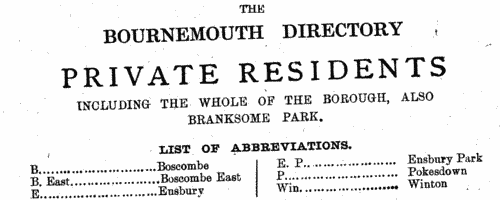
|
Research your ancestry, family history, genealogy and one-name study by direct access to original records and archives indexed by surname.
|












